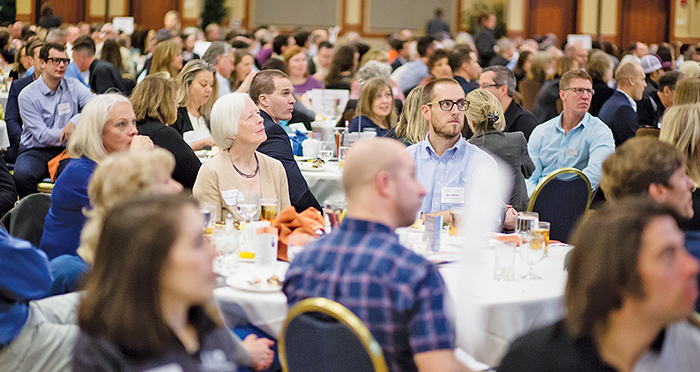(Photo above | Courtesy of EDCO)
Record-Attended EDCO Event Hears of Anticipated Boom Before 30’s Bust
A leading economist hailed Central Oregon’s continued vitality but predicted a near-term slowdown, mirroring the national cycle, which could represent an opportune time for strategic business investment prior to an upcoming “Roaring 20’s” boom period of prosperity.
Addressing the 2018 Economic Development for Central Oregon (EDCO) Annual Luncheon — which featured a record attendance at Bend’s Riverhouse Convention Center – keynote speaker ITR Economics President Ian Beaulieu highlighted many reasons for optimism going in to the next decade.
But, he warned, systemic inflation was “making a comeback”
and dark clouds loomed on the further horizon, with a predicted Great Depression-like collapse after 2030, as 70 million Baby Boomers claiming entitlements overburdened the national system.
Millennials would bear the burden of that crippling debt, but if they invested wisely could be well-positioned to take advantage of a future downturn’s “wealth-creating opportunities” before becoming the dominant generation going in to the latter half of the 2030’s.
EDCO Executive Director Roger Lee opened proceedings by remarking on the milestone achievements of the last 12 months, which saw record attendances at the organization’s Bend Venture Conference and Pub talks, and 750 attendees at this year’s annual luncheon, marking a new high for an EDCO event.
Another benchmark was set with its first $500 million quarter, in the third period of 2017, and EDCO was currently working with some 198 companies in the tri-county area as part of its primary mission of spurring “more and better jobs and a more diverse economy”.
Lee said, “Successful economic development is a team sport and we couldn’t do it without a number of collaborators, including EDCO members driving us forward.
“Our efforts have helped see the Bend-Metro area score the highest job growth and GDP growth rate in the country, as recognized by the Milken Institute ranking us the number one performing small metro area for the second year in row.
“As well as helping companies move, we continue to work with a diverse group of entrepreneurs providing the next generation of job creation, and grow existing traded sector companies – especially in target industries like biosciences, software, brewing and distilling, aviation/avionics and specialty food products.
“There are many partners in this enterprise including air service which was up 20 percent last year, and we are continuing to build internship programs, promote educational opportunities and advocate for the region at the state and local level.”
Blair Garland, Senior Director of Community Relations and Marketing for event title sponsor OSU-Cascades, highlighted the institution’s value as an asset to the community, with major economic impacts of the four-year campus including its presence representing some 1,925 jobs by 2034.
He added, “We are proud to say that that the majority of computer science students in last year’s graduating class were from Central Oregon, and many found jobs locally, and that the introduction of new programs like our Innovation Co-Lab are growing the innovators of today and tomorrow.”
Beaulieu said that the last time he addressed the EDCO luncheon, in 2015, he talked about the “winds of change” and there had since indeed been “wonderful changes” in Central Oregon, but the region was not immune to wider economic changes and political fallout, especially as more and more businesses locally were tied to the international environment.
He advised, “This is the time to act, to take risks, to borrow and invest. It is time to get ready for the Millennials’ era and a shift in power and I am enthused about the prospects for future prosperity.
“The U.S. is still the world’s largest economy, and poised for tremendous growth. Baby Boomers used to think that Russia was the main competitor superpower, but communist countries are struggling and our progress is still fundamentally about fair markets and capitalism.
“Oregon is in a special category nationally in terms of positive net migration. A lot of states are experiencing population decline which doesn’t allow for economic growth
“There is power in your state and great potential in Central Oregon.”
Beaulieu said U.S. Industrial Production and GDP levels were up over 3.4 percent but the economy overall was “about to shift to flat” and Central Oregon would see a slower rate of growth and slow down in demand in the second half of this year and through 2019.
But, he added, “You should not be upset about a temporary slow down, it is a natural process and part of business cycles.
“This does not represent a full-blown recession, just something of an ‘off year’ and you can use this time to your advantage to spool up on labor and so forth. Businesses should be about strategic plans to invest in themselves and get ready for the ‘Roaring 20’s’ — which will be great times.”
Ongoing concerns included China whose “problems are legion” including widespread pollution, with remediation costs needing to be absorbed by the economy, a hollowed-out banking system and a population imbalance caused by the “one-child” policy creating 125 million more men than women and consequent social unrest, violence, and non-corrective problems that “takes two generations to correct”.
China was investing heavily in Africa, and many of its disaffected males could be drawn to that continent, with the U.S. potentially missing out by not paying attention to opportunities there.
It was also going back to state-owned centralized enterprise, which has historically proven inefficient and a drain on the economy but still had a large appetite for investment in the U.S., with a third of foreign investment coming from China.
In terms of health care, he said the U.S. was the most expensive nation, primarily due to a “culture of keeping us alive as long as possible, often in the face of chronic illness”.
He said some 40 million Baby Boomers drawing down on social security and healthcare subsidies, representing a huge proportion of the federal budget, would rise to around 70 million by 2030, with this largest voting bloc in the U.S. making another “Great Depression” likely, before their numbers declined in the second half of the 2030’s.
He also remarked that U.S. Federal Government tax receipts compared to consumption were “drawing in red ink” and there was a cost to those interest payments not least because the largest foreign holder of Treasury interests was China and there was great financial risk if they stemmed that flow.
From a global perspective, leading indicators pointed to continued business growth and the U.S. was still a major exporting nation, with Beaulieu saying another reason he was excited for future prospects was that North America was currently the world’s largest oil-producing nation.
He added, “We are a long way from the days when we were held hostage by the Middle East in that dimension, and business continues to flow to the U.S. because we are energy independent. There is 300 years worth of oil in our ground and we produce 95 percent of what we consume.
“Another reason I am excited for this country’s prospects is manufacturing, which hit a record high before the last recession and is getting back there, leading to more job openings.”
He said a policy of tariffs on imports and protectionism had historically not led to economic benefits with competition more likely to spur innovation and efficiency.
Inflation and interest rates were on the rise, and a slow down in corporate U.S. profits would have a negative impact on the stock market, but with Price/Earnings ratios peaking this potentially necessary correction could lead to equities buying opportunities for Millennials.
He added, “I would say to Millennials; take your cash and put it in long term bonds maybe in nations like Australia with rising populations and opportunities, who are not suffering from a disproportionate burden of health care costs and so forth and from 2035-2037 put cash back into the stock market because prices will have cratered by then and could represent great wealth-creating opportunity.”
Labor relative scarcity would continue to be an issue which would need to be offset with training, re-training and recruitment policies and “companies need a professional Human Resources department or will be left behind” with even the appearance of a facility being an important factor in hiring.
Beaulieu also observed that Oregon and particularly the Central Oregon construction industry employment was coming back and wages were outpacing inflation.
Housing starts were also doing well though set to slow a little, and Bend area permit numbers spoke to population and economic growth.
He observed, “Millennials want to get married and have children and are increasingly leaving the urban environment which is great news for areas like Bend and suburban America in general.”
Beaulieu said non-residential construction was slowing down before likely picking up again after next year, and in the longer run we should plan for interest rates of seven percent-plus.
He concluded, “We are facing a new environment of systemic inflation that we have not had in 30 years. Inflation is coming back and we should plan for that reality.
“I advise preparing for the future and borrowing as much money as feasible right now with today’s attractive rates, and paying off such debt with inflated dollars down the road.”
He said another trend was a swing to career education and local further education was increasingly seen as just as important as Ivy League prestige, with distance learning also continuing to be a force.
edcoinfo.com





